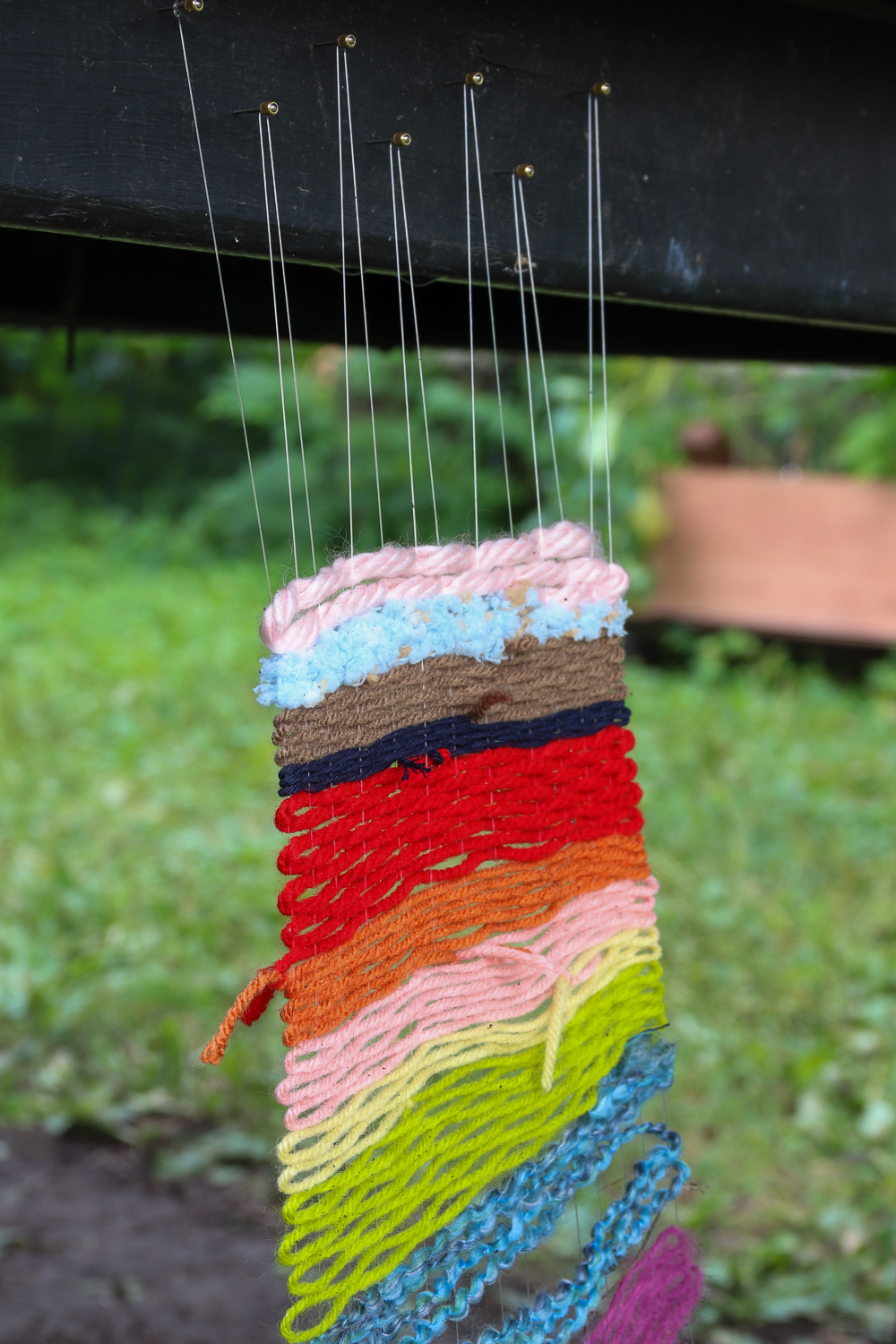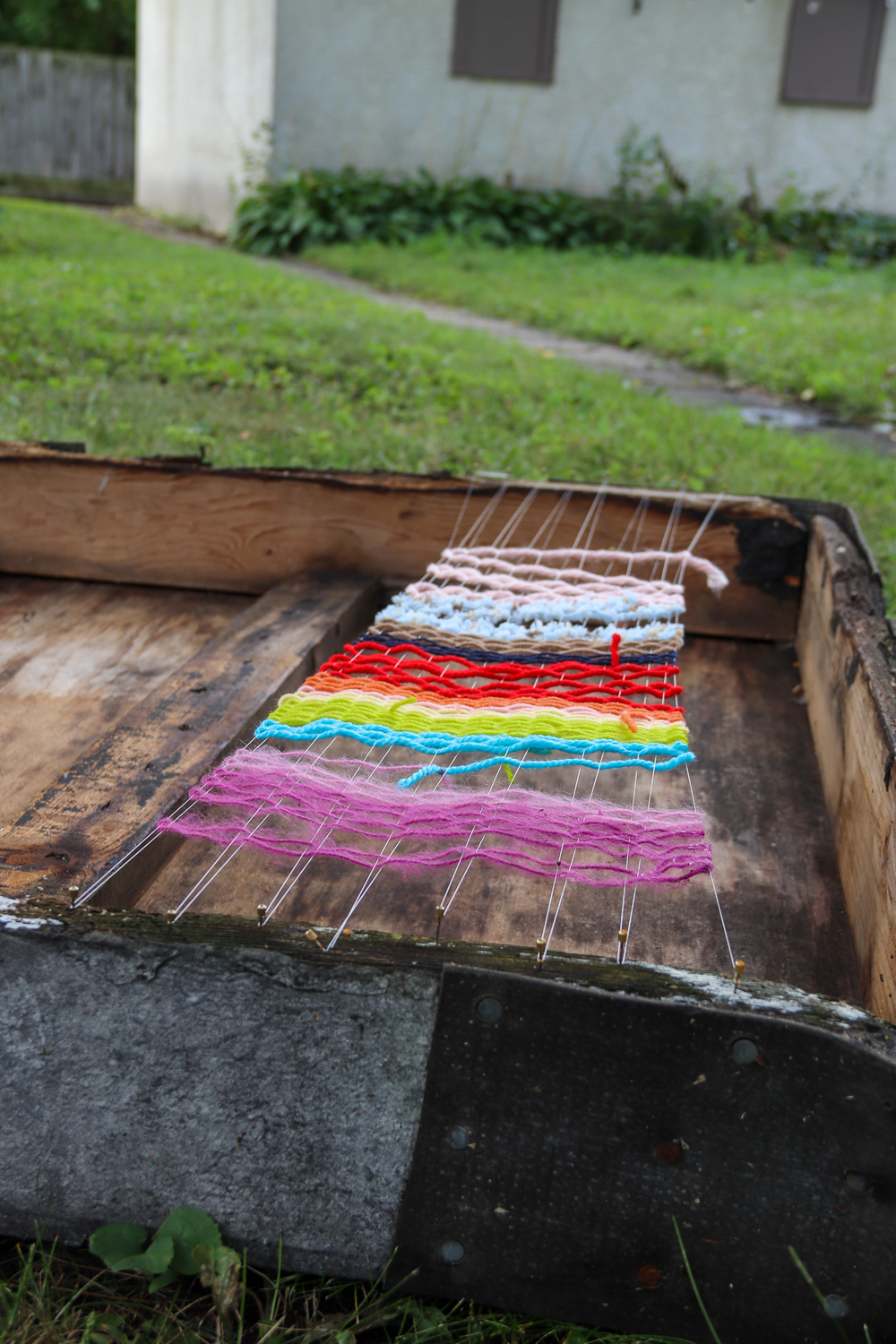Mike R. Curran
Transient Sights
Alonzo Pantoja
08/2020Transient Sights is a collection of handweavings addressing orientation, impermanence, and queerness as it relates to space and comfort. Using materials and objects already present, the work is a direct response to the space. By integrating the weavings as moments of gathering, they are temporarily co-existing and functioning as stand-ins for queerness.










Installation images by Bade Turgut.
Curatorial Essay
At the beginning of spring, ground ivy enmeshed the backyard, forming a dense patchwork of tangled vines. A delicate crown of purple flowers atop each stem promised the bloom of summer after another pale winter. That is, until the maintenance man dropped by for his inaugural mowing and imposed a crew cut on the lush disorder.
This backyard is both mine and not mine: it is mine if you consider weeding the hostas, tending the garden, and tightening the clothesline as tender forms of ownership; it is not mine if you examine the terms of tenancy dictated by a year-long lease that grants absolute authority to management. Each time the maintenance man makes his rounds, leaving grass clippings and cigarette butts in his wake, I am reminded that my presence here is provisional.
Likewise, Alonzo thinks of his handweavings as guests inhabiting this space; they mingle amongst a splintering table and balcony precariously held up by two bent legs. On his initial visit to the backyard to plan for Transient Sights, I told Alonzo that all could be moved to make room for his installation—the riding mower could be pushed around the corner, the pile of scrap wood and chipped planters placed elsewhere. He declined, choosing to instead work his rainbows into the existing landscape, where he would assemble surprising moments along unexpected focal points. Intuitive responses to texture and a consideration of the way disparate things relate drive his improvisational process—one in which proportion can be inadvertently provided by boarded up windows that run the length of the garage.
Another principle of Alonzo’s practice is that a work remains incomplete without the active presence of a viewer. He encourages you to touch his weavings, and asserts that the meaning of each is only made fully legible through your tactile engagement. With Transient Sights, Alonzo’s first outdoor show, the potential for contact extends beyond human visitors. Given their exposure to the elements, we might wonder whether the weavings become activated in an afternoon thunderstorm, or when the neighborhood cat prowls through amid his search for a chipmunk.
While art is typically sealed off from such nonhuman interactions, Alonzo generously shares space; his kindness extends not only to the bees, birds, and bugs that will wind between the cotton strands over the weekend, but to me and my apartment-mates who temporarily occupy this common area. Alonzo compels us to see our backyard in a different light, and newly notice slow shifts in shade and the material of the walkway we mindlessly cut across on the way to the compost bin.
His invitation to notice is made all the more urgent by the backyard’s location, just a handful of blocks from the Third Precinct—the epicenter of Minneapolis’ racial justice uprising in response to the police killing of George Floyd. From the first day of demonstrations, the backyard vibrated from the constant hovering of helicopters dispatched from news stations and the National Guard; tear gas particles clung to the air and mixed with the remnants of smoke from a police station destroyed to make way for something yet to be determined.
Those continuing to demonstrate here in the Twin Cities and across the country are reaching for the transformation of broken systems. Alonzo’s practice embodies that transformative potential: by centering queerness—in all of that term’s action-oriented and expansive possibilities—throughout his work, he strives towards the making of new worlds. While that often looks like challenging the heteronormativity enforced in dominant spaces, Transient Sights additionally confronts our tendencies to expropriate land and worship individualism from the fenced-in altars of private backyards.
We are in a moment between pessimism and reevaluation. Over the course of writing this essay even, I learned that ground ivy is an invasive brought to what is now the United States by European colonizers. What I initially interpreted as a lush patchwork is actually a dense mat that stifles the growth of neighboring vegetation. As we wade through these shifting ecological and political landscapes, we would do well to follow Alonzo’s rainbows and reconsider the varying ways we relate to one another within a shared backyard, surrounded by both neglect and possibility.
This backyard is both mine and not mine: it is mine if you consider weeding the hostas, tending the garden, and tightening the clothesline as tender forms of ownership; it is not mine if you examine the terms of tenancy dictated by a year-long lease that grants absolute authority to management. Each time the maintenance man makes his rounds, leaving grass clippings and cigarette butts in his wake, I am reminded that my presence here is provisional.
Likewise, Alonzo thinks of his handweavings as guests inhabiting this space; they mingle amongst a splintering table and balcony precariously held up by two bent legs. On his initial visit to the backyard to plan for Transient Sights, I told Alonzo that all could be moved to make room for his installation—the riding mower could be pushed around the corner, the pile of scrap wood and chipped planters placed elsewhere. He declined, choosing to instead work his rainbows into the existing landscape, where he would assemble surprising moments along unexpected focal points. Intuitive responses to texture and a consideration of the way disparate things relate drive his improvisational process—one in which proportion can be inadvertently provided by boarded up windows that run the length of the garage.
Another principle of Alonzo’s practice is that a work remains incomplete without the active presence of a viewer. He encourages you to touch his weavings, and asserts that the meaning of each is only made fully legible through your tactile engagement. With Transient Sights, Alonzo’s first outdoor show, the potential for contact extends beyond human visitors. Given their exposure to the elements, we might wonder whether the weavings become activated in an afternoon thunderstorm, or when the neighborhood cat prowls through amid his search for a chipmunk.
While art is typically sealed off from such nonhuman interactions, Alonzo generously shares space; his kindness extends not only to the bees, birds, and bugs that will wind between the cotton strands over the weekend, but to me and my apartment-mates who temporarily occupy this common area. Alonzo compels us to see our backyard in a different light, and newly notice slow shifts in shade and the material of the walkway we mindlessly cut across on the way to the compost bin.
His invitation to notice is made all the more urgent by the backyard’s location, just a handful of blocks from the Third Precinct—the epicenter of Minneapolis’ racial justice uprising in response to the police killing of George Floyd. From the first day of demonstrations, the backyard vibrated from the constant hovering of helicopters dispatched from news stations and the National Guard; tear gas particles clung to the air and mixed with the remnants of smoke from a police station destroyed to make way for something yet to be determined.
Those continuing to demonstrate here in the Twin Cities and across the country are reaching for the transformation of broken systems. Alonzo’s practice embodies that transformative potential: by centering queerness—in all of that term’s action-oriented and expansive possibilities—throughout his work, he strives towards the making of new worlds. While that often looks like challenging the heteronormativity enforced in dominant spaces, Transient Sights additionally confronts our tendencies to expropriate land and worship individualism from the fenced-in altars of private backyards.
We are in a moment between pessimism and reevaluation. Over the course of writing this essay even, I learned that ground ivy is an invasive brought to what is now the United States by European colonizers. What I initially interpreted as a lush patchwork is actually a dense mat that stifles the growth of neighboring vegetation. As we wade through these shifting ecological and political landscapes, we would do well to follow Alonzo’s rainbows and reconsider the varying ways we relate to one another within a shared backyard, surrounded by both neglect and possibility.